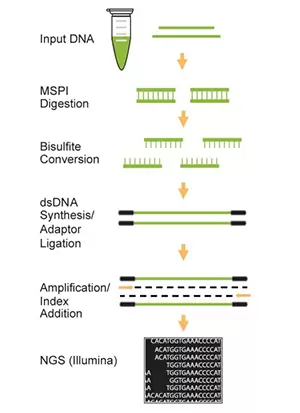EpiNext RRBS Library Fast Kit
Successfully prepare a library directly from bisulfite DNA generated from a tiny amount of input DNA
Product Description
The EpiNext™ RRBS Library Fast Kit is designed to prepare reduced representative bisulfite sequencing (RRBS) DNA libraries for an Illumina platform. The optimized protocol and components of the kit allow subnanogram DNA to be used for MSP1 DNA digestion and bisulfite conversion, followed by non-barcoded (singleplexed) or barcoded (multiplexed) library construction in less than 4 hours.
Advantages and Features
- Allows for rapid size-appropriate CpG-rich DNA fragment preparation and bisulfite conversion. The bisulfite DNA can be directly ligated to adaptors, thereby eliminating the possibility of breaking adaptor-ligated fragments, which often occurs with other RRBS methods.
- The procedure from DNA enzyme digestion to ready-to-use library DNA can be completed within 4 hours.
- Completely converts unmethylated cytosine into uracil (>99%) with negligible inappropriate- or error-conversions of methylcytosine to thymine.
- High sensitivty and efficiency - Innovative adaptor ligation of bisulfite DNA eliminates loss of fragments and selection bias, enabling input DNA to be as low as 10 ng, making it ideal for methylation profiling of precious, limited samples. The kit can be used for both non-barcoded (singleplexed) and barcoded (multiplexed) DNA library preparation.
- The kit contains all required components for each step of DNA library preparation, which are sufficient for MSPI digestion, bisulfite conversion, ligation, clean-up, size selection, and library amplification, thereby allowing the bisulfite DNA library preparation to be streamlined for the most reliable and consistent results.
- Ultra HiFi amplification enables the achievement of reproducibly high yields of DNA libraries with minimal sequence bias and low error rates.
- Starting materials can be genomic DNA isolated from various tissue/cell samples such as fresh and frozen tissue, cultured cells from a flask or microplate, microdissection samples, paraffin-embedded tissue, biopsy, embryonic cells, plasma/serum samples, and body fluid samples.
Background Information
DNA methylation occurs by the covalent addition of a methyl group (CH3) at the 5-carbon of the cytosine ring, resulting in 5-methylcytosine (5-mC). DNA methylation is essential in regulating gene expression in nearly all biological processes, including development, growth, and differentiation. Alterations in DNA methylation have been demonstrated to cause a change in gene expression. For example, hypermethylation leads to gene silencing or decreased gene expression, while hypomethylation activates genes or increases gene expression. Aberrant DNA methylation is also associated with the pathogenesis of diseases such as cancer, autoimmune disorders, and schizophrenia. Thus, genome-wide analysis of DNA methylation could provide valuable information for discovering epigenetic markers used for disease diagnosis and potential targets used for therapeutics. Reduced representation bisulfite sequencing (RRBS) is the most used genome-wide DNA methylation analysis method. It enriches CpG-rich DNA fragments with restriction enzyme digestion and converts unmethylated cytosine to uracil, while 5-mC remains unmodified by the bisulfite treatment. Epigenetic differences are interpreted as genetic differences, which can then be detected by sequencing at single-base resolution and on a genome-wide scale. However, traditional RRBS is still not practical for many reasons. (1) It requires relatively large amounts of DNA as input material, which is difficult to prepare from limited biological samples such as tumor biopsy, early embryos, embryonic tissues, and circulating DNA. (2) DNA must be sheared first and then ligated to adaptors, followed by bisulfite conversion (post-ligation bisulfite conversion). This procedure causes most of the DNA fragments (contained in the adaptor-DNA fragment constructs) to be broken, resulting in the formation of mono-tagged templates that will be removed during library enrichment. Thus, incomplete coverage and bias occur when performing RRBS. (3) The method is also time-consuming, taking approximately 2 days.
Principle & Procedure

This kit includes all reagents required for successfully preparing a library directly from bisulfite DNA generated from a tiny amount of input DNA. In this preparation, size-appropriate CpG-rich DNA fragments are enriched by MSPI digestion and bisulfite converted. The bisulfite-treated DNA, in single-stranded form, is then simultaneously converted to dsDNA and adaptor-ligated. Next, the ligated fragments are size-selected and purified using MQ Binding Beads, followed by amplification with a high-fidelity PCR Mix. The procedure ensures maximum yields from minimum amounts of starting material and provides highly accurate amplification of library DNA with low error rates and minimum bias.
Starting Materials
Starting materials can be genomic DNA isolated from various tissue/cell samples such as fresh and frozen tissue, cultured cells from a flask or microplate, microdissection samples, FFPE tissue, plasma/serum, body fluid samples, etc. DNA should be without any previous restriction digestion step. Plasmid DNA can be used for bisulfite treatment with or without previous linearization, as the kit allows for DNA denaturation status to remain during the entire DNA bisulfite conversion process and direct ligation of adaptors to bisulfite DNA. The input amount of DNA can be from 10 ng to 400 ng. For optimal preparation, the input amount should be 200 ng.
You save 5 %
1.338,00 €
